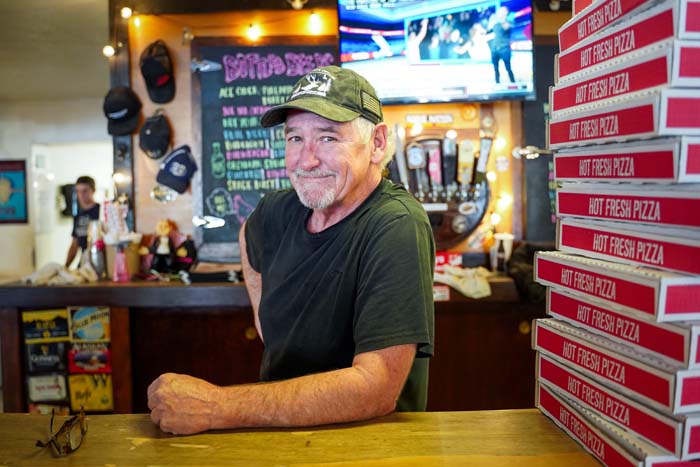Local restaurants embrace impacts of nationwide pandemic struggles
Published 7:00 am Thursday, August 12, 2021

- Bruce Rogers, owner of Local Harvest, stands at the counter on Thursday, July 29, 2021. Local Harvest received $56,597 in government funding from the Restaurant Revitalization Fund.
LA GRANDE — With restaurants in need, grant funding has helped keep the doors open for some local favorites.
Trending
The Small Business Administration awarded $28.6 billion worth of federal government funds to aid restaurants across the country impacted by COVID-19 through the Restaurant Revitalization Fund. In early May, more than 2,000 restaurants in Oregon received funds from the grant, eight of which are in Union County.
“We would have had to close,” said Bruce Rogers, owner of Local Harvest in La Grande. “We were of course thankful for it because we wouldn’t have stayed open without the grants we received.”
Local Harvest joined Mamacita’s International Grill, Side A Brewing, Merlyn’s Catering, Moy’s Dynasty and Le Bebe Cakes Bakery as restaurants in La Grande to receive a portion of the funding distributed through the RRF. Gravy Dave’s in Union and The Elgin Station Bar and Grill also received grants.
Trending
Restaurants in need
Out of approximately 100,000 restaurants in the United States to receive funds from this grant, Oregon’s percentage of the funds ranked in the top 20 states. After distributing the grants throughout May and June, the funding closed in early July. The New York Times reported that approximately 300,000 applicants from across the country submitted applications, but only about a third of the applicants were awarded funding.
Adding up all the applications, a total need of $65 billion was requested from restaurants across the country. According to the Small Business Association, nearly 5,000 Oregon businesses applied for the grant, requesting $1.2 billion. This immense need in the restaurant industry has brought about lobbying efforts for Congress to revitalize the program with more funds and create a second wave of grants.
“We encouraged everyone who needed it to apply,” said Greg Astley, director of Government Affairs for the Oregon Restaurant and Lodging Association. “The hole created from the past 16 months to get where we are isn’t going to be easy to get back out of.”
Mamacita’s International Grill received $178,527 from the RRF, the most of any restaurant in Union County, while Side A Brewing ($109,128) and Moy’s Dynasty ($100,523) also reached six figures. Despite leading the county, these numbers are well below the national average of about $270,000 per restaurant and well below the largest recipients in Oregon, with Capers Cafe and Catering Co. in Portland receiving $6.9 million.
Keeping the doors open
For Rogers and Local Harvest, the $56,597 received from the RFF was a means to continue employing the staff and keeping doors open through tough times.
“We were able to take care of the people who bust their butts for us. That’s how it helped us the most,” Rogers said.
The rise in product prices have been the most detrimental to the Local Harvest, alongside the obvious decrease in customers during the pandemic. Rogers said prices are up nearly 25% at his restaurant due to a major increase in supply prices.
Rogers primarily used the grant money for payroll, which allowed the business to maintain its indoor dining. Many restaurants in the area and across the country were forced to close indoor dining during the peak of the pandemic. While a takeout-only model decreases overall sales, it allows businesses to spend less on costs related to keeping a building open such as utilities and server wages.
“If we’re losing more money staying open, we’ll just close and lose less money,” Rogers said. “Don’t get me wrong, we’re grateful for every bit of help we got. We’d rather close the inside of the restaurant than cut off the people who have supported us through the pandemic.”
Employment shortage
While the demand for the RRF was extensive, not all business owners are completely in favor of continued government-funded relief. Merlyn Baker, owner of Merlyn’s Catering Co., believes the biggest issue now is the lack of reliable employees looking for work. With unemployment available, restaurants are among the many businesses struggling to bring in new employees during difficult financial circumstances.
“There isn’t one problem that we have economically right now in our nation that can’t be filled by people going back to work,” Baker said. “I’ve had to turn away more business this year than ever just simply because we don’t have enough employees.”
The catering service is managing to stay afloat, but Baker has had to limit his restaurant hours at The Landing Hotel and personally works more than 20 hours per day. He said he received more than 700 employment applications since the start of the pandemic, but only hired about 10 employees after rejecting incomplete applications and experiencing applicants not showing up for the interview or quitting quickly.
“What hasn’t been addressed is adaptation,” Baker said. “We just keep getting more money from the government.”
Facing a potential second round
A major concern of restaurant owners is the recent spike in COVID-19 cases. Most restaurants are using funding like the RRF to dig themselves out of a hole that has been costing their business for upward of 16 months. With restaurants finally allowed to open again for indoor dining last spring, some owners now are preparing for the worst.
“We made the mistake of thinking this was over,” Rogers said. “When they opened everything back up, we put everything back to normal.”
If indoor capacity limits or even indoor dining closures are enacted again, some businesses will face difficult decisions. With many businesses left out in the first round of funding and the possibility of a spike in the pandemic, the National Restaurant Association and others in the industry are pushing for a second wave of the Restaurant Revitalization Fund that would include an additional $60 billion in relief funds.
“We need that fund replenished and we need to have a plan in place for if we start seeing lockdowns again,” Astley said. “If we start seeing the prohibitions on indoor dining again, I think even more restaurants won’t survive this round.”








